Tour Guides
1. Chania, beautiful city
by Manolis Skouloudis, Athens 1974.

"Chania is a beautiful city. The most beautiful in Crete, one might even say in the whole of Greece. Chania has a natural, privileged, well-protected beauty. Sleepless guardians to the south stand the gigantic Madares mountains in all their indestructible, panoramic glory. To the north stretches the multicoloured immensity of the Sea of Crete, embraced by its gorgeous, long-armed capes. And all around lies its land, scarlet and green-haired, sown with wild silver gorges. A land that seems to be made flesh, so spirited and alive that you hesitate to tread on it."
Chania, location
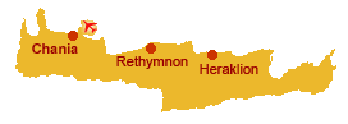
Chania lies on the north coast of west Crete and is the capital of Chania Prefecture. Chania Prefecture covers the westernmost end of Crete and features a combination of many beautiful beaches, small fertile plains, high mountains and deep gorges, such as the Samaria Gorge. Chania Prefecture is the greenest part of the island, as the range of the White Mountains ensures the highest rainfall in Crete.
Chania is one of the oldest cities in Crete, with a rich and tumultuous history. Today it is the second most populated city on the island, a city which has preserved its traditional architecture and most of its monuments from Venetian and Turkish times. The Venetian harbour with its lighthouse and the old town in the centre have bestowed on Chania the reputation of the most picturesque city in Crete, welcoming thousands of visitors each year.
Chania does not lag behind in modern developments, as it is home to the Technical University of Crete and other educational establishments. It also offers many and varied cultural events and amusements.
New town of Chania
You could say that Chania consists of two towns, the old and the new, which coexist in a harmonious whole. The new town embraces the old and spreads outwards ever wider. Its layout is fairly good near the centre and it's easy to find your way around. Unfortunately this changes in the suburbs, where it's easy to get lost. It is commonly observed that its is very easy to find your way into Chania but much harder to get out. Of course, you may not want to leave, as Chania is a city that will enchant you.
Chania old town
The heart of Chania is still the old town, with its narrow, labyrinthine alleyways and listed buildings dating from different periods, where you can enjoy romantic strolls. Many of these buildings have been turned into small hotels, restaurants, shops or homes.
Don't hesitate to wander round the alleys of the old town, looking for the lovely images that await you. Your camera must be your inseparable companion, as Chania is one of the most-photographed cities in Greece.
The old town stretches out parallel to the Venetian harbour, from Firkas Fortress and the Maritime Museum to the "Pyli tis Ammou" (Gate of the Sand, or Koum Kapi in Turkish) to the east of the arsenals. This is the part of town within the Venetian walls and includes Byzantine Chania, once enclosed within less extensive walls.
The Byzantine walls protected the fortress of Kastelli, the hill which was first inhabited in the Neolithic period.
Kastelli Hill rises above the Turkish mosque in the Venetian harbour. Here stood the acropolis of ancient Kydonia, the Minoan Chania. There, too, was built the first Byzantine fortress, the Kastelli, surrounded by walls with many towers and bastions. The Venetians established their headquarters there in 1252, building the Rector's Residence (the Rector was the Governor of Chania), while the same site was the seat of the pashas during the Turkish Occupation. During the last years of Turkish rule, the Christian aristocracy lived inside the Kastelli. Unfortunately most of the district was destroyed by bombing during the Second World War, and its medieval aspect was lost forever. Today only the base of the north wall remains. There is also the main road that once ran through the Kastelli, modern-day Kanevaro Street with its imposing mansions.
2. SAMARIA GORGE
Samaria or the Samaria Gorge is one of the main sights of Crete. Every tourist who visits Crete will have heard of this beautiful gorge or soon will. The locals call it the "Farangas" or "Great Gorge", both in admiration at its beauty and to differentiate it from the many other, smaller gorges of Crete.
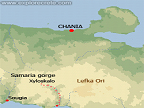
The Samaria Gorge is in west Crete, in the White Mountains. It is the longest gorge in Europe, with a length of 18 kilometres.
The gorge starts at Xyloskalo (1227 m. above sea level) on the Omalos Plateau and runs down to the seaside village of Agia Roumeli on the south coast of Crete.
Samaria Gorge, Flora and Fauna
The Samaria National Park is exceptionally rich in plant and animal life. In the gorge you will find unique species protected under international law.
It is said that there are 450 plant species in the gorge, and not a single flower may be removed from Samaria, by law. Don't see this as a pointlessly strict rule, but as the only way to protect the delicate ecosystem of Samaria so that thousands of visitors can continue to enjoy it each year.
In Samaria you can admire the forests of huge pine and cypress trees, a picture from Crete's past, when the island was covered by forests famous for their timber, ideal for building strong ships.

Inside the gorge you may even meet its famous inhabitants, the wild goats of Crete, which the locals call "agrimia" and tourists call "kri-kri".
The Cretan wild goat is endemic to Crete and you will probably see some in the village of Samaria, as they often approach the houses at the edge of the village.
A brief visit to the Samaria Gorge
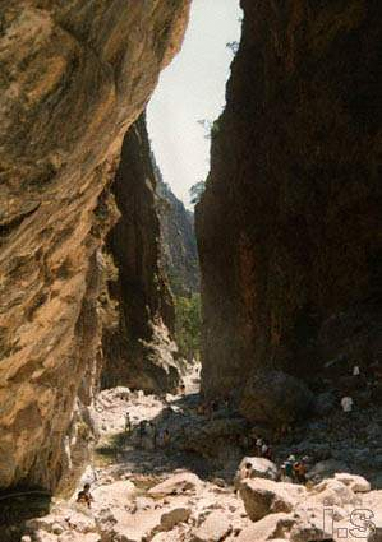
The walk through the Samaria Gorge takes 4-8 hours depending on your pace. Six hours is the normal time, especially if you stop to take pictures and enjoy the amazing natural landscape.
However, if you don't feel up to the whole route, there is also the "lazy way" as the tour agents call it.
This is a much shorter route from Agia Roumeli up to the "Iron Gates" (Sideroportes), the narrowest point of the gorge.
At the Iron Gates, the gorge is so narrow that you can almost touch both sides as they rise up sheer 350 metres above your head.
The short route is certainly an easy way to experience some, though not all, of the magic of the Samaria Gorge.
Samaria gorge hiking, tips and equipment
Samaria is not a simple stroll for those unused to walking.
Anyone can go down the gorge, as long as they have no serious medical problems, but you must be prepared for very stiff legs the next day. A good pair of hiking shoes is a must, as well as sunblock and a hat.
The most tiring part of the walk is the last 3 km before the exit from the National Park. Here there is often another ticket control to make sure no-one is left in the gorge overnight, either because they have had an accident or because they want to.
The landscape at the exit from the gorge is dry and arid with no shade. If you have started your walk in the early morning, you will reach this point in the early afternoon, when the heat of the day is more obvious.
Be patient, because just another hour's walk away is Agia Roumeli with its inviting beach.
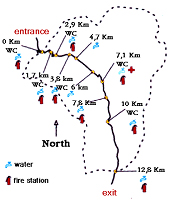
3. RETHYMNON
The old town of Rethymnon is one of the best-preserved towns of the Renaissance. Lying in the heart of modern Rethymnon, it combines the oriental features of the Turkish period with Renaissance-style Venetian architecture.
After the Venetian conquest of Crete (1204), the town of Rethymnon was built according to the rules of Venetian architecture. The original craftsmen were Venetians, but these later were replaced by Cretan murari, Venetian-trained master builders.
The layout of Rethymnon is directly linked to the sea, with the main Venetian street, the Ruga Maistra (today's coastal Venizelou Avenue) running parallel to the sea. The opposite is true of Heraklion and Hania, where the town is closed to the sea for reasons of defence and the main street is at right angles to the coast.
The private mansions of Rethymnon are not as impressive as those of Venice, mainly for financial reasons. Furthermore, the strong traditions of Cretan architecture could not be overcome, and Renaissance influences are most apparent on building facades.
Finally, as opposed to Heraklion and Hania, Greek features are predominant in Rethymnon because most nobles were Greeks, known as "Archondoromeoi" (noble "Romans", that is, inhabitants of the Eastern Roman Empire).

Many buildings with gothic features were lost in the destruction of the town by Ulu Ali in 1571, while Rethymnon was rebuilt almost in its entirety in the third quarter of the 16th century.
Many fine examples of Turkish architecture are preserved scattered around the narrow streets of the old town.
Their main feature is the heavy use of wood. Building styles changed during the years of the Turkish occupation (1646-1898) and the dressed stone of the Venetians was replaced by a wooden frame filled with rubble and mud (bagdati). The walls were then thickly plastered. The upper storey almost always projects out over the street (sahnisi) and is faced with wood, often with kafasoto latticework.
In Rethymnon the Turks made full use of the existing Venetian public and private buildings, which they modified according to their needs.
Today the old town of Rethymnon is a living museum of monuments of past centuries. Despite the damage sustained in the Second World War, many Venetian and Turkish monuments still stand, especially as the town has not been struck by major earthquakes.
4. Frangokastello, general
Frangokastello (or Frangocastello) is in the area of Sfakia, on the south coast of west Crete, 13 kilometres east of Chora Sfakion and west of Plakias.
Frangokastello is a small seaside village with a few houses and quite a few rooms for rent and apartments for tourists. It is famous for its Venetian castle of the same name, which is preserved in very good condition, its beautiful beaches and the Drosoulites, the ghosts which appear at Frangokastello at dawn each May. Many monuments were built in the area through the centuries, but very few survive today. Most were destroyed in the wars and risings in the area, and the stones from their ruins used to build the castle.
Frangokastello lies in a surprisingly small plain in the shadow of the eastern range of the White Mountains, with the gorge and mountain of Kallikratis. This landscape is one of the many surprises the natural environment of Crete has to offer visitors.
Frangokastello, useful information
At Frangokastello you will find many rooms and apartments for your holiday, along with several tavernas serving delicious food and fresh fish. Don't forget to try the traditional local specialities such as tsigariasto (sautéed kid or lamb), boureki (courgette potato bake) and Sfakianes pites (sweet cheese pies).
There is also a mini-market in Frangokastello, but if you need cash the nearest cashpoint is in Chora Sfakion, where the rural surgery also operates.
For nightlife there is a friendly little bar in Frangokastello.
How to get to Frangokastello from the west
To get to Frangokastello from Chania, you need to drive up to Askyfou Plateau and then descend to Chora Sfakion, driving alongside the imposing sheer cliffs of the Imbros Gorge. Soon you will see the endless blue of the Libyan Sea stretching out before you. Drive slowly and carefully on the hairpin bends, and remember that there may be a tourist coach coming up which will need the whole width of the bend to turn in.
Shortly before Chora Sfakion, turns left (east) and follow the signs to Frangokastello. The journey is approximately 1.5 hours' drive from Chania.
How to get to Frangokastello from the east
If you're coming from the east, leave Rethymno and head towards Plakias. Before Plakias, follow the signs to Rodakino, Frangokastello and Chora Sfakion. The route is quicker and easier than that from Chania, and takes about an hour from Rethymno.
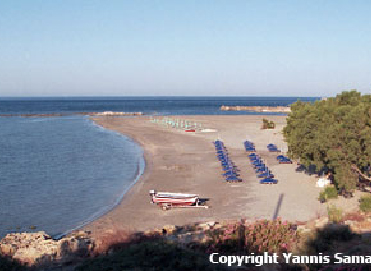
Frangokastello beaches
Right in front of the castle is a lovely beach with very shallow water, ideal for small children.
West of the castle is another beach with pebbles and a rocky seabed suitable for snorkelling. Most of the rooms and apartments are on this side of the village.
About 300 metres east of the castle is one of the most beautiful beaches in Crete, known as "Orthi Ammos" ("Standing Sand"), named after the sand dunes you have to scramble down to reach the water. The sea is crystal-clear and the bottom slopes down very gently.
A small secret of Frangokastello is that to enjoy it you must not come when a north wind is blowing or the sea will be rough and the sand will blast you mercilessly. Unfortunately the high mountains and the plain with few trees funnel the northerlies, something that happens in most of southern Crete.
The castle of Frangokastello
What remains of the castle of Frangokastello today is not very different from the way it looked when it was first built in 1371, but most of it was essentially reconstructed in the 19th century by Mustapha Naili Pasha, the same man who had destroyed it earlier when defeating the fighters of Hadzi Michalis Dalianis.

Frangokastello was built according to the principles of fortification in the days before gunpowder and the "bastion system" that followed. It was never brought up to date because the area was of secondary importance to the Venetians.
The castle consists of four square towers linked by sheer curtain walls topped by serried battlements, forming a rectangular building. There is a small, arched entrance on the east side, while the main gateway, on the south, is decorated by carved coats of arms of noble families set into the walls. Above the entrance stands the winged lion of St Mark, the emblem of the Republic of Venice.
The southwest tower is larger than the other three and therefore more important, because it a) is larger, b) has a wider field of view, c) was the last place of defence if the castle was overrun, and d) protected the south main gate.
Along the inside of the walls were rectangular buildings, not perfectly preserved, which were used as barracks, stables, storerooms, kitchens, ovens, etc.

